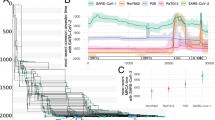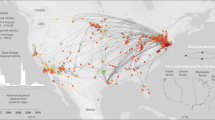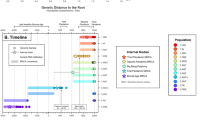Abstract
Paramyxoviruses are responsible for considerable disease burden in human and wildlife populations: measles and mumps continue to affect the health of children worldwide, while canine distemper virus causes serious morbidity and mortality in a wide range of mammalian species. Although these viruses have been studied extensively at both the epidemiological and the phylogenetic scales, little has been done to integrate these two types of data. Using a Bayesian coalescent approach, we infer the evolutionary and epidemiological dynamics of measles, mumps and canine distemper viruses. Our analysis yielded data on viral substitution rates, the time to common ancestry, and elements of their demographic history. Estimates of rates of evolutionary change were similar to those observed in other RNA viruses, ranging from 6.585 to 11.350 × 10−4 nucleotide substitutions per site, per year. Strikingly, the mean Time to the Most Recent Common Ancestor (TMRCA) was both similar and very recent among the viruses studied, ranging from only 58 to 91 years (1908 to 1943). Worldwide, the paramyxoviruses studied here have maintained a relatively constant level of genetic diversity. However, detailed heterchronous samples illustrate more complex dynamics in some epidemic populations, and the relatively low levels of genetic diversity (population size) in all three viruses is likely to reflect the population bottlenecks that follow recurrent outbreaks.




Similar content being viewed by others
References
Anderson RM, May RM (1991) Infectious diseases of humans: dynamics and control. Oxford University Press, Oxford
Barrett T (1994) Rinderpest and distemper viruses. In: Webster RG, Granoff A (eds) Encyclopedia of virology. Academic Press, New York, pp 1260–1269
Bartlett MS (1957) Measles periodicity and community size. J R Stat Soc A 120:48–70
Bellini WJ, Rota PA (1998) Genetic diversity of wild-type measles viruses: implications for global measles elimination programs. Emerg Infect Dis 4:29–35
Bolt G, Jensen TD, Gottschalck E, Arctander P, Appel MJ, Buckland R, Blixenkrone-Moller M (1997) Genetic diversity of the attachment (H) protein gene of current field isolates of canine distemper virus. J Gen Virol 78:367–372
Carbone KM, Wolinsky JS (2001) Mumps virus. In: Fields BN, Knipe DM, Howley PM (eds) Virology. Lippincott Williams & Wilkins: Philadelphia, PA, pp 1381–1400
Domingo E, Holland JJ (1997) RNA virus mutations for fitness and survival. Annu Rev Microbiol 51:151–178
Drummond AJ, Rambaut A (2003) BEAST v1.0. Available at: http://www.evolve.zoo.ox.ac.uk/beast/
Drummond AJ, Nicholls GK, Rodrigo AG, Solomon W (2002) Estimating mutation parameters, population history and genealogy simultaneously from temporally spaced sequence data. Genetics 161:1307–1320
Drummond AJ, Rambaut A, Shapiro B, Pybus OG (2005) Bayesian coalescent inference of past population dynamics from molecular sequences. Mol Biol Evol 22:1185–1192
Drummond AJ, Ho SYW, Phillips MJ, Rambaut A (2006) Relaxed phylogenetics and dating with confidence. PLoS Biol 4(5):e88
Ewens WJ (2004) Mathematical population genetics. 2nd ed. Springer-Verlag, New York
Fauquet CM, Mayo MA, Maniloff J, Desselberger U, Ball LA (eds) (2005) Virus taxomomy: classification and nomenclature of viruses. Elsevier Academic Press, New York
Grenfell B, Harwood J (1997) (Meta)population dynamics of infectious diseases. Trend Ecol Evol 12:395–399
Griffin DE (2001) Measles virus. In: Fields BN, Knipe DM, Howley PM (eds) Virology. Lippincott Williams & Wilkins, Philadelphia, pp 1401–1441
Hanada K, Suzuki Y, Gojobori T (2004) A large variation in the rates of synonymous substitution for RNA viruses and its relationship to a diversity of viral infection and transmission modes. Mol Biol Evol 21:1074–1080
Jenkins GM, Rambaut A, Pybus OG, Holmes EC (2002) Rates of molecular evolution in RNA viruses: a quantitative phylogenetic analysis. J Mol Evol 54:156–165
Kosakovsky Pond SL, Frost SDW (2005) Datamonkey: rapid detection of selective pressure on individual sites of codon alignments. Bioinformatics 21:2531–2533
Lamb RA, Kolakofsky D (2001) Paramyxoviridae: the viruses and their replication. In: Fields BN, Knipe DM, Howley PM (eds) Virology. Lippincott Williams & Wilkins, Philadelphia, pp 1305–1340
Mochizuki M, Hashimoto M, Hagiwara S, Yoshida Y, Ishiguro S (1999) Genotypes of canine distemper virus determined by analysis of the hemagglutinin genes of recent isolates from dogs in Japan. J Clin Microbiol 37:2936–2942
Orvell C (1994) Measles virus. In: Webster RG, Granoff A (eds) Encyclopedia of virology. Academic Press, New York, pp 838–847
Orvell C, Tecle T, Johansson B, Saito H, Samuelson A (2002) Antigenic relationships between six genotypes of the small hydrophobic protein gene of mumps virus. J Gen Virol 83:2489–2496
Panum PL (1939) Observations made during the epidemic of measles on Faroe Islands in the year 1846. Med Class 3:829–886
Posada D, Crandall KA (1998) MODELTEST: testing the model of DNA substitution. Bioinformatics 14:817–818
Pybus OG, Charleston MA, Gupta S, Rambaut A, Holmes EC, Harvey PH (2001) The epidemic behaviour of the hepatitis C virus. Science 292:2323–2325
Rambaut A (1996) Se-Al: Sequence Alignment Editor. Available at:http://www.evolve.zoo.ox.ac.uk/
Rima BK (1994) Mumps virus. In: Webster RG, Granoff A (eds) Encyclopedia of virology. Academic Press, New York, pp 876–883
Robbins KE, Lemey P, Pybus OG, Jaffe HW, Youngpairoj AS, Brown TM, Salemi M, Vandamme A-M, Kalish ML (2003) US human immunodeficiency virus type 1 epidemic: Date of origin, population history, and characterization of early strains. J Virol 77:6359–6366
Rota JS, Hummel KB, Rota PA, Bellini WJ (1992) Genetic variability of the glycoprotein genes of current wild-type measles isolates. Virology 188:135–142
Uzicanin A, Eggers R, Webb E, Harris B, Durrheim D, Ogunbanjo G, Isaacs V, Hawkridge A, Biellik R, Strebel P (2002) Impact of the 1996–1997 supplementary measles vaccination campaigns in South Africa. Int J Epidemiol 31:968–976
WHO (1999) Progress toward measles elimination—Southern Africa, 1996–1998. MMWR 48:585–589
WHO (2007) Measles fact sheet. Available at: http://www.who.int/mediacentre/factsheets/fs286/en/
Woelk CH, Jin L, Holmes EC, Brown DWG (2001) Immune and artificial selection in the hemagglutin (H) glycoprotein of measles virus. J Gen Virol 82:2463–2474
Woelk CH, Pybus OG, Jin L, Brown DWG, Holmes EC (2002) Increased positive selection pressure in persistent (SSPE) versus acute measles virus infections. J Gen Virol 83:1419–1430
Acknowledgments
We thank Rubing Chen for assistance with the BEAST analyses, Bryan Grenfell for advice on measles demography and statistics, and two anonymous reviewers for useful comments. Laura Pomeroy was supported by the National Science Foundation, under the NSF Graduate Teaching Fellowship in K-12 Education (DGE-0338240). This work was also supported by NIH Grant GM080533-01.
Author information
Authors and Affiliations
Corresponding author
Rights and permissions
About this article
Cite this article
Pomeroy, L.W., Bjørnstad, O.N. & Holmes, E.C. The Evolutionary and Epidemiological Dynamics of the Paramyxoviridae. J Mol Evol 66, 98–106 (2008). https://doi.org/10.1007/s00239-007-9040-x
Received:
Revised:
Accepted:
Published:
Issue Date:
DOI: https://doi.org/10.1007/s00239-007-9040-x




